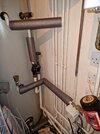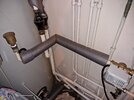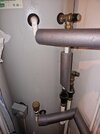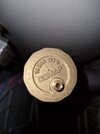Hi there,
We have a sealed central heating system with a water tank. Every time the hot water goes on, the pressure in the system goes down by 1/2 a bar and there is a gurgling sound which I believe is because of air trapped in the pipes. I believe there is a way to bleed the coil going into the water tank but I have no idea how to do that?
Would anyone be able to explain how we can do it? I'm attaching photos.
Thanks!
Juan
We have a sealed central heating system with a water tank. Every time the hot water goes on, the pressure in the system goes down by 1/2 a bar and there is a gurgling sound which I believe is because of air trapped in the pipes. I believe there is a way to bleed the coil going into the water tank but I have no idea how to do that?
Would anyone be able to explain how we can do it? I'm attaching photos.
Thanks!
Juan







